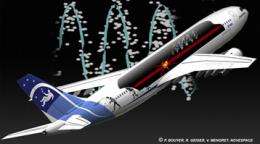Developing more accurate cold atom accelerometers

For the first time, a team of French physicists, supported by CNES and ESA, has succeeded in developing a vibration-resistant cold atom accelerometer. Tested in parabolic flight, this prototype was able to measure infinitesimal accelerations, which until now was only possible in the laboratory. This could pave the way for the development of portable cold atom accelerometers and thus improved positioning and geological prospecting systems. It could also make it possible to directly test aspects of Einstein's general theory of relativity. The results are published in the journal Nature Communications.
Accelerometers using atomic waves are far more accurate than traditional accelerometers, which are used for example in smartphones or on board satellites and ships. The downside is that their operating principle makes them fragile as they rely on atoms laser-cooled to temperatures near absolute zero. The atoms then behave in a wave-like manner, like light beams, making it possible to build matter-wave interferometers that are extremely sensitive to accelerations. This particularity is put to use in atom accelerometers, but at the price of diabolical experimental complexity and extreme sensitivity to vibrations.
Operating them on board Novespace's Airbus “A300 ZERO-G”, which performs parabolic flights to simulate microgravity, was therefore a real challenge. To achieve this, the team of researchers developed a novel technique consisting in merging the data collected by both the atom accelerometer and conventional accelerometers. This enabled them to measure the acceleration of the aircraft with an accuracy several hundred times greater than that of other accelerometers, despite strong signal interference due to permanent jolting.
The demonstration of the viability of this atom accelerometer under difficult conditions opens the way to commercial applications. The model used in flight was bulky (4 m3), but the CNRS scientists have since developed a portable version, the size of a travelling trunk. Due to be marketed next year, it is mainly intended for geophysics research laboratories. In fact, any variation in the composition of the Earth's crust is reflected in the local gravitational field: by finely mapping this gravitational field using an atom accelerometer, it could be possible to identify mineral veins, monitor underground seismic or volcanic activity, control the safety of oil wells, etc.
In terms of fundamental research, the accelerometer will be used to test the equivalence principle of general relativity, according to which the acceleration of gravity is the same for all objects. It is precisely for this reason that the researchers have made sure that their instrument could withstand parabolic flight, during which the device is briefly subjected to microgravity. The principle of equivalence will be put to the test during forthcoming in-flight experiments, with two atom accelerometers operating with different types of atoms. The scientists will thus be seeking to determine whether the accelerometers give exactly the same results. A positive response would mean that Einstein was right.
Provided by CNRS


















